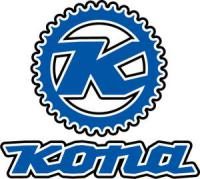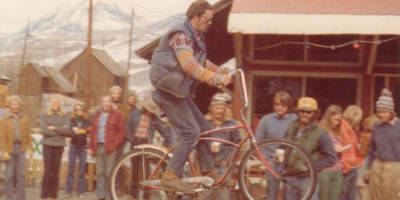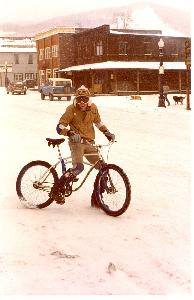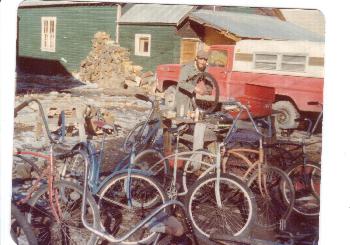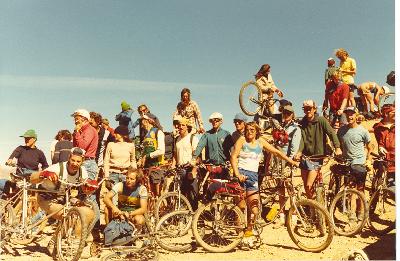Fat Tire Bike Week
Crested Butte fetes its role in mountain biking lore..By R. Scott Rappold
|
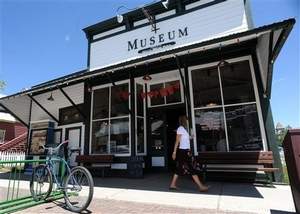 | CRESTED BUTTE, Colo. — Glo Cunningham's first attempt to ride Pearl Pass did not begin well.
"I had a three-speed and two of my three speeds broke on my way up the hill out of town," the 61-year-old cyclist from Crested Butte recalled. "Fortunately, the one that worked was the low gear."
The year was 1980 and these were not the sleek, lightweight bicycles of today, but 35-pound monstrosities, Schwinns meant for leisurely trips on gentle pavement. Pearl Pass was the opposite, an old, 40-mile mule train route between Crested Butte and Aspen, which tops out at 12,700 feet, holds snow through August and runs through some of the roughest terrain in Colorado.
More parties on wheels than the organized rides of today, these early trips have become legendary, as Crested Butte cyclists "pushed, dragged and carried" their "klunkers" into mountain biking history.
Late last month, cyclists celebrated the 30th anniversary of Fat Tire Bike Week, the nation's oldest mountain bike festival. Its roots are traced to these rides over Pearl Pass, and it is an iconic event for Colorado's iconic mountain-biking town.
We headed there to find out how Crested Butte contributed to the sport, and to meet some of the folks who made it happen.
In 1975, the Aspen guys rolled into Crested Butte on motorcycles, chasing local girls and boasting about how they had conquered heinous Pearl Pass on their machines.
Such a slight demanded a response from the guys at the Grubstake Bar. They had to one-up the Aspen crowd. They wanted to ride into that other town and chase Aspen girls.
Someone had heard there was free beer.
So began the Pearl Pass Klunker Tour.
In 1976, as today, just about everyone in Crested Butte had a bike. But it was mostly pragmatism; the town's unpaved streets were so pot-holed, riding a bike to get around was easier than driving.
The mines had long since shut down, and while skiing had opened for business in 1961, the town was still an isolated enclave, with one road in and out in winter — a haven for free spirits and flower children.
"We're talking about a very unpopulated, very depressed mining town that had shut down. Even the skiing didn't get any back," said longtime resident Don Cook, who moved here for skiing and the fact a 17-year-old could get served in bars.
A handful of local riders, in September of 1976, launched the first "klunker" tour, named for the no-frills bikes they rode. They spent the first day struggling, sweating and cursing up the rough road to Pearl Pass and camped high in the mountains.
Said the Crested Butte Pilot newspaper: "The group and groupies made camp, enjoyed a steak fry and consumed one keg of beer, three bottles of Schnapps, 2 gallons of wine, and 3 bottles of champagne."
Only two riders made the whole trip without jumping into support vehicles.
"The descent was nothing but horrifying, rough and rocky," rider Bob Starr, one of the two, told the newspaper. "The original drop-outs jumped out of support vehicles at the tip and all 15 rode their klunkers down the pass until just before the pavement at Ashcroft where the brakes were smoking and rear ends were seizing up."
History has not recorded if they were successful with the Aspen girls. Cunningham doubts it.
"They spent two days getting to Aspen — two days of dust and sweat. They probably weren't the most attractive men in the Aspen scene," she said. The event might have remained a one-time local curiosity, had a writer for the Bohemian magazine CoEvolution Quarterly not heard of it. The magazine did a story, and by 1978 word had reached a group of riders in California, including mountain bike pioneers Joe Breeze, Charlie Kelly and Gary Fisher.
These were guys who, since the mid-'70s, had been designing and tweaking bicycles to race down the rough fire roads of Marin County, Calif. In 1976, they held the first Repack downhill race. In 1978, one of them called the Grubstake.
Most of the riders in Crested Butte were out of town in 1977, working as forest firefighters, so there had been no Pearl Pass ride. The Marin County boys wanted to take part in the '78 ride.
The response among the 1976 riders: "We have to do it again?"
When the Marin County riders arrived with their bikes — light machines, thin-walled, with chrome-moly tubing — riders in Crested Butte were impressed.
"Their bikes are — in a word — sophisticated," marvelled the Pilot newspaper.
The California riders rode almost all the way to the Pearl Pass summit, while the locals pushed their "first-generation, one-speed klunkers."
"They definitely were not more advanced riders. Just better bikes," said Cunningham. And soon the riders from Crested Butte, with their help, had better bikes than anyone else in town. Neil Murdoch rode on the 1976 Pearl Pass ride and opened the second mountain bike shop in the world, in Crested Butte. By the early 1980s, people were coming a week ahead of the ride to acclimate, so he conceived Fat Tire Bike Week to bring a little extra business to a town that was usually empty in summer.
By this time, salespeople in the fledgling business had created the name "mountain bike." Who wanted to pay $1,500 for something called a "klunker?" By 1983, 400 people were coming to town for the ride.
Mountain biking had evolved beyond Pearl Pass. It turned out the countless miles of trails built in the national forests by the Civilian Conservation Corps in the 1930s made great singletrack.
"In a small town like this, when you've got something that's ahead like that, everybody wants to be part of it," said longtime rider Kay Peterson-Cook. "By 1980, we had started exploring. We had found a few other places to ride. By 1981, we had found a lot of places to ride."
"Just the youthful feeling, playing in the dirt, just about reminded anybody of the feeling of being a kid, thinking 'Yahoo, I haven't felt like this since I was 10 years old!'" said Don Cook, her husband.
Cook and some other riders founded the Crested Butte Mountain Bike Association in 1983, another first of its kind. Meanwhile, Fat Tire Week grew every year, attracting corporate sponsorship in 1989. The festival was moved to June, too early to ride Pearl Pass — that event remained in September. There were rodeos, races and clinics, and, of course, demos by the countless companies getting in on the business of mountain biking.
Crested Butte had become the first mountain bike destination.
Cook is often asked about the early Pearl Pass rides. He was on the sidelines in 1978, rode in 1980 and has ridden it countless times since.
Gear has improved immensely. Some locals like to ride to Aspen in the morning, have lunch, and then ride home.
Today, only 20 or 30 people take part in the September rides.
Locals in Crested Butte acknowledge theirs will always be the second city of mountain-biking history.
"We pretty much have to say that technologically, it happened on the West Coast," said Peterson-Cook.
But Crested Butte's legacy has been cemented. Without events here, it may not have attained the media coverage and respectability, not to mention interest generated, to make it a mainstream sport — at least not for a while.
And the festival remains a big draw, the start to summer where summers are short.
"You're young, you're having the time of your life. You can't believe there are all these people from all these places from all over the United States who want to come do these things that you love," said Cook. There is an unsigned plaque in the Mountain Biking Hall of Fame, which today has a place in the Crested Butte Mountain Heritage Museum, about the Pearl Pass days.
"Getting to the top of the pass and remembering that people used to ride it with hangovers on 45-pound Schwinns, with high-rise handlebars and before that in mule trains, makes it interesting."
|
|
Fat Tire Bike Week History
|
|
The historic mining town of Crested Butte lies at 9,000 feet, ringed by the imposing Elk Mountains. The town’s Victorian storefronts cozy together today just like they did in the rowdy Old West days, and guests have compared its laid back friendliness to Andy Griffith’s Mayberry. But Crested Butte is no sleepy backwoods burg; its spirit is decided young, lively and adventurous.
|
|
|
Blame the potholes for starting the whole biking thing. When Crested Butte had no paved roads (the streets in Crested Butte were paved in the summer of 1983) the locals got tired of trashing their cars in the ruts just driving from home to the post office. Someone figured out that a good alternative, short of reverting back to horses, was to use old balloon-tire bikes that were rusting away in garages and trash heaps.
|
|
|
So a few enterprising souls including Steve Baker and Al Maunz dug the metal corpses out of bicycle graveyards and gave them a new life. Soon bikes became the accepted means of getting around town--and dodging potholes.
In 1976, bicycles carved a milestone in Crested Butte’s history. That was the year the guys from the Grubstake Bar hopped on their one-speed clunkers and rode over the 12,705 ft. Pearl Pass to harass the town of Aspen, some 40 miles over the hill. This perilous expedition was in response to a gang of Aspen motorcyclists who frequently dropped down from the Pass to raise a fuss in Crested Butte and vanish into the sunset with the local ladies. CB wanted revenge—and got it.
|
|
|
Since that year, bikes became a symbol of the town’s honor, and the tradition has been kept alive with an annual trip over the pass every September. During the following years, Crested Butte hooked up with a faster crowd, some stump-jumping, boulder-hopping cyclists from Marin County, California, who had developed a peculiar machine with big tires, wide handlebars and plenty of gears. They called this thing the mountain bike.
When the Californians breezed into town with their new inventions, hoping to test them on Pearl Pass, it was love at first sprocket. The CB crowd had never seen such elaborate bikes. To put it mildly, Crested Butte went head over wheels and the place has not been the same since.
|
|
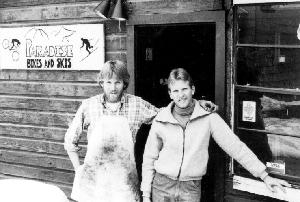 | In 1980 a couple local riders bolted away from the group with the California hot rods, and began racing up the first leg of the tour to base camp. In the summer of 1981, those local riders, the Cook Brothers, decided to have a race the day before the tour to provide an outlet for the competitive urge, and the Paradise Divide Fat Tire Stage Race (first-ever mountain bike stage race) was started. It was dubbed that because the cross-country race route went over the 11,372 foot Paradise Divide. The cross-country stage included a timed uphill and downhill competition within the stage and the race also had a criterium on the unpaved streets of Crested Butte. That same year the tour expanded into a full blown festival and Fat Tire Bike Week, the oldest mountain biking festival in the world, was born. Eventually, organizers moved Fat Tire Bike Week into early July (peak wildflower season) then into late June where it remains today. The Pearl Pass Tour remains in September, where the possibility of snow flurries is almost guaranteed.
|
|
|
The Fat Tire Bike Week festival set the standard for mountain biking festivals across the world. It combined fun, humor, serious competitions, educational clinics, social events and backcountry tours. At its peak it attracted thousands of riders from all abilities to gather and have a fantastic time on bikes. The competitions ranged from intense (the Fat Tire Bike Week Stage Race, the Keystone Downhill and observed trials) to the outlandish (like the Chainless Race and Bicycle Rodeo, with its log pull, bicycle limbo, corkscrew criterium and car-jumping events). There were mechanics competitions and Official Mountain Bike Polo.
Beyond the clinics, picnics, races, games and spectator events, the tours were a special draw for many people. Each day, guides led rides geared to specific ability levels into Crested Butte’s natural wonderlands and historic landmarks. The tours were a wonderful way to meet people and share the camaraderie of getting to explore a new area.
Fat Tire Bike Week also hosted the annual induction ceremony for the Mountain Bike Hall of Fame. This made sense seeing that Crested Butte was also the location to the Mountain Bike Hall of Fame’s museum. Mountain biking history was so fast-paced and colorful that Crested Butte bikers created the museum before its history was lost. From the first inductions in 1988, and on through 1996, the Crested Butte festival was the home to the ceremony where mountain bike legends were honored (since 1997, the ceremony is held in conjunction with the annual Interbike Show).
Fat Tire Bike Week currently is organized through the Crested Butte/ Mt. Crested Butte Chamber of Commerce. The Fat Tire Bike Week Stage Race is now the Wildflower Rush. Both events are held in late June and are run separately. For more information please go to these links.
Fat Tire Bike Week ftbw.com
|
|
|
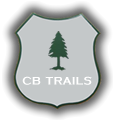
 Crested Butte History
Crested Butte History 